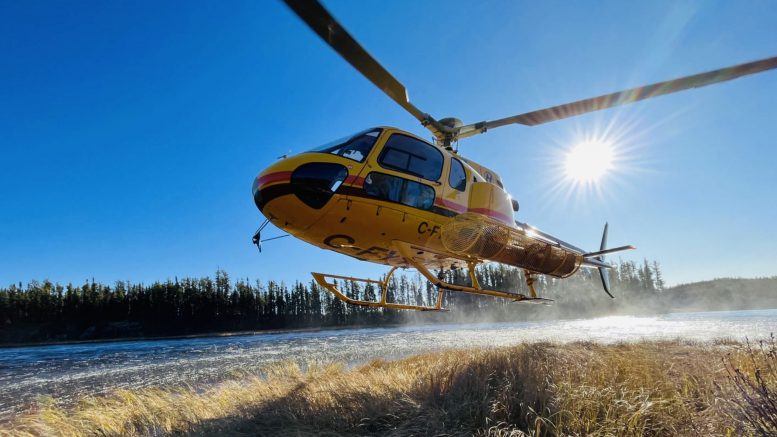Ramp Metals (TSXV: RAMP) shares fell 25% on Monday after it reported assay results from its Rottenstone SW project in Saskatchewan that were a fraction of the mineralization in a discovery announced last month.
Drill hole Rogue-01 cut 4.5 metres grading 0.66 gram gold per tonne from 14 metres depth, Ramp said in a release that was upbeat on the results. Hole Rogue-02 returned 1.5 metres at 0.6 gram from 216.5 metres downhole; and Rogue-03 cut 1 metre at 1.22 grams from 243 metres depth.
Those holes, wrapping up all of Ramp’s initial drilling last year at the 325-sq.-km project about 700 km north of Regina, compared with the Ranger-01 hole reported June 18. It hit 7.5 metres of 73.55 grams gold and 19.5 grams silver starting at 227 metres downhole.
The shares, which the company said are held 60% by management and directors, closed at 56¢ apiece on Monday in Toronto, down from 75¢ on Friday. The shares are still up nearly 200% since listing in March at 19¢. The company is valued at $18.1 million.
CEO Jordan Black considered how the Rogue holes expanded mineralization at the site: “What makes this news release even more bullish than the last is we hit gold 3 km away from the discovery hole, so it shows a cross-regional strike,” the executive said by phone on Monday.
“We’re super excited,” said Black, a geological engineer who joined Ramp after a stint in venture capital. “Hitting gold in all four holes on our first four holes ever on the property is something people dream of their whole life.”
Rottenstone mine
The gold discovery was startling, Black said, since the historical Rottenstone mine area is known more for nickel than gold and Ramp had been seeking magmatic nickel-copper. He criticized how the market seemed to contrast the newly-released assays with the discovery.
“The grades from two different targets cannot be compared,” he said. “One would never expect to consistently hit high grade in the same target, let alone across two different targets.”
Ramp is betting on a geological trend 30 km southwest of the former Rottenstone open pit mine, named by local First Nations for the appearance of the hill where the mine was dug. It produced nickel, platinum group metals (PGM) and gold from 1965 to 1969, and is now held by Fathom Nickel (CSE: FNI).
Ramp sees a comparison with the eye structure of the Nova-Bollinger nickel-copper mine in Western Australia that Sirius Resources sold to IGO (ASZ: IGO) for A$1.8 billion ($1.7 billion) in 2015. Mark Bennett, who led Sirius, is an adviser to Ramp.
“That’s why we staked this eye structure here because I found it had very close similarities to the Nova-Bollinger structure,” Garrett Smith, vice-president for exploration, said by phone on Friday.
“When we flew our magnetic and electro-magnetic surveys, we got these textbook nickel sulphide targets,” Smith said. “Everything was just kind of fitting the model and we pretty much just decided to drill it straight off magnetic and electro-magnetic results.”
The Canadian junior also sees an opening since most prospectors in northern Saskatchewan are focused on uranium and the world-class Athabasca basin for the nuclear fuel, but not other metals.
“Saskatchewan is very underexplored,” the exploration chief said. “Everybody just seems to have blinders on for uranium in the basin. So, we always saw that as a huge opportunity for us to build a land package, or pretty much anything we wanted, because nobody was out there looking for anything else.”
Regional system
In the 1960s, mining at Rottenstone produced 26,057 tonnes with an average grade of 3.28% nickel, 1.83% copper and 9.63 grams per tonne of palladium, platinum and gold from resources estimated to range from 45,000 tons (40,800 tonnes) to 60,000 tons, Fathom Nickel says.
“To get those grades, and in the quantity that they did get them, it really speaks to a much larger regional system,” Smith said. “If they can trace back maybe a long structure, or find out where the feeder zones are for this thing, then you really could be on to something.”
Ramp’s first assay, for the Ranger hole, appeared deceiving because the cores resembled granite kitchens, but closer inspection showed zones with more foliation or strain, Smith said.
“We joked around when we first drilled it was countertop-looking rock for 170 metres – it’s not where you would expect to find PGEs or even gold for that matter,” he said. “The mineralization appears to be very, very subtle. It’s not super obvious. If you’re looking at this core, it’s easily missed.”
Young prospectors
Saskatchewan natives Smith and Brett Williams, vice-president of operations and senior geologist, amassed land claims after graduating in 2017. The duo retains a 2% net smelter return royalty on the company’s holdings, which also include the modestly explored copper-nickel-PGM Peter Lake Domain project about 200 km north of Rottenstone SW, and the early-stage Railroad Valley lithium project in Nevada.
The company began trading on the Toronto Venture Exchange after completing a reverse takeover of Anacott Acquisition for $500,000. It raised $1.2 million during the go-public stage and spent a large part of it on the drilling so far. Ramp may raise more funds for 3,000 metres to 5,000 metres of drilling this year and surveys, the CEO said.
The company has been in discussions with local First Nations based in Lac La Ronge about 115 km south the project.
“We were the first company to reach out to them before being prompted by the government,” Smith said. “We’ve kept a very close relationship with them.”
Clarification: The article adds context on Ramp’s share price and its $1.2 million capital raising that the initial posting lacked.


See prior comments in last article…..
-so the drill hole Ranger 01 was drilled in a “trend” located 30 km southwest of Rottenstone, which is a nickel sulfide occurrence….
-what was the geology and mineralization that produced 7.5 meters @ 73 g/t Au reported in Ranger 01?